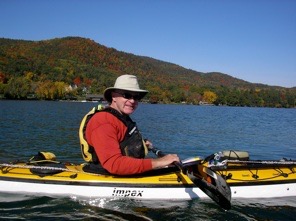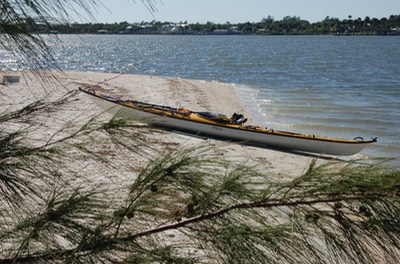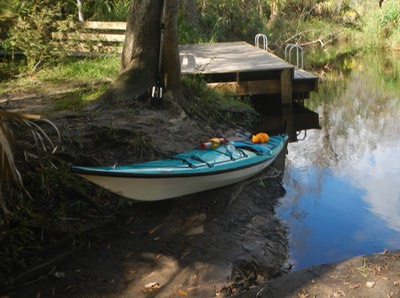
One of our landings. High tide is at the tree line.
We had paddled the Saguenay Fjord four years before (Click here to see that earlier trip report). But this trip was so different from that earlier trip that you might think we had paddled in two very different places. Then we paddled and camped along the south shore. This time we would stick to the north shore of the Fjord. Then we struggled with bright sunshine and heat. This time we struggled with cold, wet, foggy weather. The south side was laced with many beautiful waterfalls. The north side had almost none. Landings to be fair were about the same, with the north side having slightly flatter landings with smaller boulder fields. The tidal range on this trip was thirteen (13) to twenty (20) feet, about what we experienced before. And on both sides, the camping takes place in a vertical world.
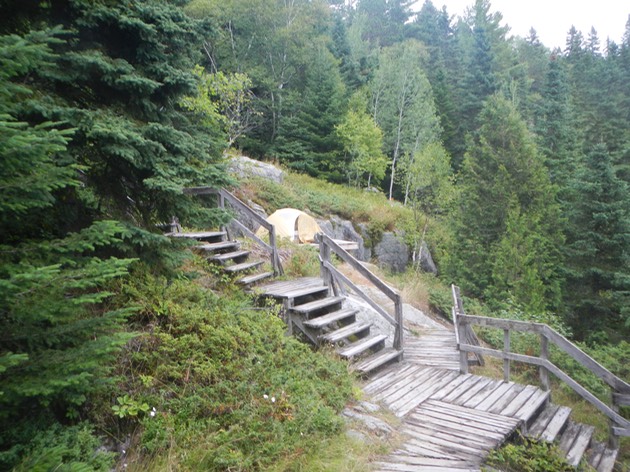
Picture this. You land your campsite at or near low tide. The high tide mark is some 150 yards away over a jumble of boulders and loose gravel. You unload all the gear from your heavily laden boat, and making several trips, haul it above the high tide mark. Then you and three of your strongest friends carry the boats one by one to safety above the high tide line.
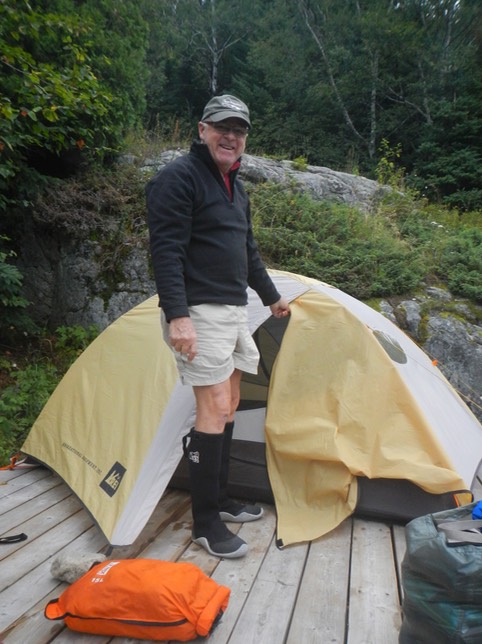
Now you’re ready to set up camp. Camping is on designated platforms, usually no more than six (6) at any site. You are assigned to specific platforms by the park authority. Carrying as much gear as you can, you climb up the equivalent of five to seven flights of stairs to your site (if you are lucky, there are stairs. Often its just a muddy track.). Once there, the wooden platforms are usually large and in good repair with magnificent views. Its good to take a break, set up a chair and just take in the wilderness for awhile. That’s one of the reasons we come here!
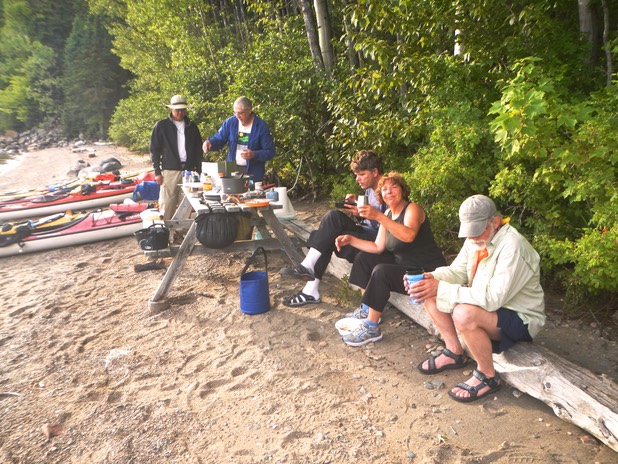
On the older sites there is usually one communal picnic table for cooking and eating. However, some of the sites that get heavier usage now have covered cooking and eating pavilions. These are sweet; great places to cook and congregate for communal meals.
I was anxious about this trip in a way that I wasn’t four years ago. For one thing, I’m four years older. And while four years doesn’t sound like much, the difference between 66 and 70 does. Secondly, Lisa and I were on the road away from home for a full three weeks before this trip began. All of my planning and packing for this eight day unsupported paddling trip was done a month before. Given the forecasts at the time I expected warm weather and packed accordingly. The week before the trip the forecasts turned cold, rainy and windy. I went to L.L. Bean in Albany and purchased some warmer clothing. As it turned out, it was cold at times , there was some rain, some wind and lots of fog. But there were also clear mornings and sunny afternoons when we could let our gear dry out and soak up the warmth,
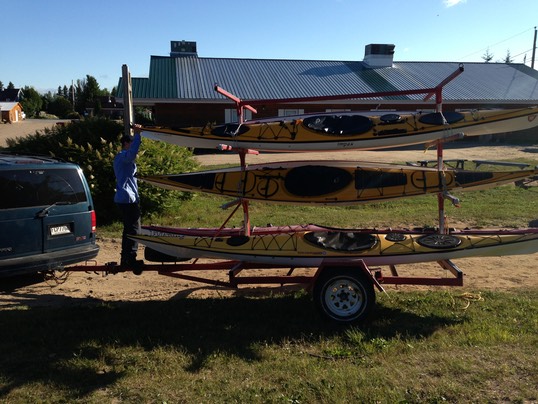
The overall planning for the trip was done by Bruce Romanchak. Bruce selected the trip dates based on tide charts for the area and input from the paddlers. He reserved six platforms at six sites along the north side of the fjord between Cap Jaseur and Tadoussac. Bruce also identified two outfitters who could transport us and our gear to the put-in or from the take-out and passed that information on to Kaare Christian who volunteered to setup this part of the adventure. Kaare had the good sense to put us all in a cabin on the evening of our travel day before launch. This only cost a bit more than reserving six tent camping sites and let us start off warm and dry.
At one point we had seven people committed to the trip - Bruce Romanchak (Castelton, NY), Kaare Christian and wife Robin Raskin (NYC), Tom Doo (Princeton, NJ), Scott Keller (Clarksville, NY), Alan Lovegren (Philadelphia, PA) and Don Yackel (Sebastian, FL). This group of friends from all over the East Coast was initially brought together on several Great Hudson River Paddle trips, organized by Scott Keller. We have paddled together on one adventure or another ever since. Unfortunately, Alan had to withdraw at the last minute because of a serious work conflict. But being a trooper and good guy, he drove to Tom’s house in Princeton to deliver the food and gear he promised to contribute to the group effort. Thank you Alan!
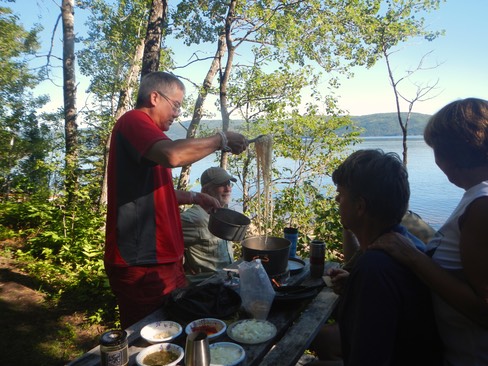
Food on a long paddling trip is important. Six people all cooking their own dinners didn’t make sense. So I rallied folks around cooking communal meals. Scott volunteered to make crab cakes, Robin made Pepper Steak, Don made Pad Thai and Tom helped both Scott and Don prepare the meals Alan sent; soup and Linguini with Clam Sauce and Tuna Noodle Casserole. Everything was hearty and delicious!
I can’t say enough good things about Bruce’s planning for the trip. In addition to the reservations, bruce provided us with charts for each day’s paddle taken from the Canadian Coast Guard’s Marine/Air Sea Rescue charts. He also provided us with tide tables and GPS coordinates for all of our campsites and points of interest. Because he had the most knowledge about the area and had previously shown good judgement on the water, Bruce was unanimously appointed trip leader.
Our route was as follows:
- Day 0: Travel to Tadoussac and the Five Star Farm Resort
- Day 1: Cap* Jaseur to Anse** de Sable
- Day 2: Anse de Sable to Baie*** de la Trinite
- Day 3: Baie de la Trinite to Anse du Portage
- Day 4: Anse du Portage to Anse aux Ilets Rouges
- Day 5: Anse aux Islets Rouges to Pointe**** a Passe-Pierre
- Day 6: Pointe a Passe-Pierre to Tadoussac
- Day 7: Travel Home
- (Translations: *Cap* - a cape, **Anse - a cove or small bay, ***Baie - a large bay, ****Pointe - a point of land)
The pages and videos that follow flesh out this trip. In addition, I have provided links to the reports on our previous trip on the Saguenay.
- Go to Daily REPORTS
- Also See
( Underlined dates are completed. Others are still in process.)
